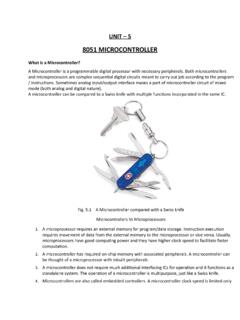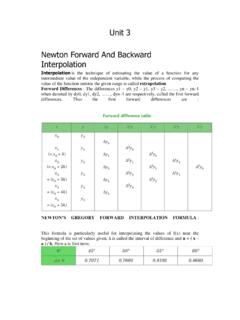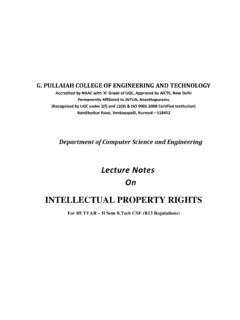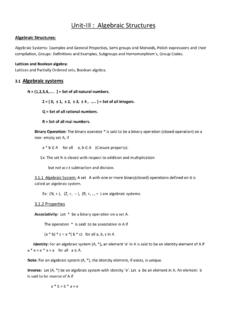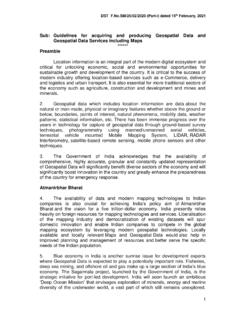Transcription of LECTURE NOTES ON REMOTE SENSING & GIS
1 REMOTE SENSING & GISLECTURE NOTES ONREMOTE SENSING & GISIV B. Tech II semester (JNTU (A)-R13) VEENA Assistant COLLEGE OF ENGINEERING AND TECHNOLOGYCIVIL ENGINEERINGBY VEENA ASST. PROFESSORPage 1 REMOTE SENSING & GISOBJECTIVES: understand the Photogrammetric techniques, concepts, components of PhotogrammetryOUTCOMES: On completion of the course the students will have knowledge on Principles of photogrammetry Analysis of RS and GIS data and interpreting the data for modeling applicationsUNIT IINTRODUCTION TO photogrammetry : Principles& types of aerial photograph, geometry of vertical aerial photograph, Scale & Heightmeasurement on single vertical aerial photograph, Height measurement based on reliefdisplacement, Fundamentals of stereoscopy, fiducially points, parallax measurement usingfiducially BOOKS:1 REMOTE SENSING and GIS by , Oxford University Press,New of REMOTE SENSING by gorge Joseph , Universities press, Hyderabad BY VEENA ASST.
2 PROFESSORPage 2 REMOTE SENSING & GISUNIT-1 PhotogrammetryPhotogrammetry is the science of making measurements from photographs, especially forrecovering the exact positions of surface points. Moreover, it may be used to recover themotion pathways of designated reference points located on any moving object, on itscomponents and in the immediately adjacent environment. photogrammetry may employ high-speed imaging and REMOTE SENSING in order to detect, measure and record complex 2-D and 3-Dmotion fields. photogrammetry feeds the measurements from REMOTE SENSING and the resultsof imagery analysis into computational models in an attempt to successively estimate, withincreasing accuracy, the actual, 3-D relative motions within the researched field.
3 Its applications include satellite tracking of the relative positioning alterations in all Earthenvironments ( tectonic motions etc.), the research on the swimming of fish, of bird orinsect flight, other relative motion processes. The quantitative results of photogrammetry arethen used to guide and match the results of computational models of the natural systems, thushelping to invalidate or confirm new theories, to design novel vehicles or new methods forpredicting or/and controlling the consequences of earthquakes, tsunamis, any other weathertypes, or used to understand the flow of fluids next to solid structures and many is as old as modern photography, can be dated to the mid-nineteenth century,and its detection component has been emerging from radiolocation.
4 Multilateration andradiometry while its 3-D positioning estimative component (based on modeling) employsmethods related to triangulation, trilateration and multidimensional the simplest example, the distance between two points that lie on a plane parallel to the photographic image plane can be determined by measuring their distance on the image, if the scale (s) of the image is known. This is done by multiplying the measured distance by 1 for photogrammetry typically attempt to minimize the sum of the squares of errorsover the coordinates and relative displacements of the reference points. This minimization isknown as bundle adjustment and is often performed using the Levenberg is the science of making measurements from photographs, especially forrecovering the exact positions of surface points.
5 Moreover, it may be used to recover theBY VEENA ASST. PROFESSORPage 3 REMOTE SENSING & GISmotion pathways of designated reference points located on any moving object, on itscomponents and in the immediately adjacent environment. photogrammetry may employ high-speed imaging and REMOTE SENSING in order to detect, measure and record complex 2-D and 3-Dmotion fields . photogrammetry feeds the measurements from REMOTE SENSING and the resultsof imagery analysis into computational models in an attempt to successively estimate, withincreasing accuracy, the actual, 3-D relative motions within the researched applications include satellite tracking of the relative positioning alterations in all Earthenvironments ( tectonic motions etc.)
6 , the research on the swimming of fish, of bird orinsect flight, other relative motion processes. The quantitative results of photogrammetry arethen used to guide and match the results of computational models of the natural systems, thushelping to invalidate or confirm new theories, to design novel vehicles or new methods forpredicting or/and controlling the consequences of earthquakes, tsunamis, any other weathertypes, or used to understand the flow of fluids next to solid structures and many otherprocessesPhotogrammetry is as old as modern photography, can be dated to the mid-nineteenth century,and its detection component has been emerging from radiolocation.
7 Multilateration andradiometry while its 3-D positioning estimative component (based on modeling) employsmethods related to triangulation, trilateration and multidimensional the simplest example, the distance between two points that lie on a plane parallel to thephotographic image plane can be determined by measuring their distance on the image, if thescale (s) of the image is known. This is done by multiplying the measured distance by 1 for photogrammetry typically attempt to minimize the sum of the squares of errorsover the coordinates and relative displacements of the reference points. This minimization isknown as bundle adjustment and is often performed using the Levenberg Marquardtalgorithm.
8 The photogrammetry has been derived from three Greek words: Photos: means light Gramma: means something drawn or written Metron: means to measureThis definition, over the years, has been enhanced to include interpretation as well asmeasurement with :The art, science, and technology of obtaining reliable information about physicalobjects and the environment through process of recording, measuring, and interpretingphotographic images and patterns of recorded radiant electromagnetic energy andphenomenon .Originally photogrammetry was considered as the science of analysing onlyphotographs.
9 But now it also includes analysis of other records as well, such as radiated acousticalenergy patterns and magnetic phenomenonDefinition of photogrammetry includes two areas:BY VEENA ASST. PROFESSORPage 4 REMOTE SENSING & GIS(1)Metric: It involves making precise measurements from photos and other informationsource to determine, in general, relative location of points. Most common application: preparation of plannimetric and topographic maps. (2)Interpretative: It involves recognition of objects and judging their significance throughcareful and systematic analysis. It includes photographic interpretation which is the study ofphotographic images.
10 It also includes interpretation of images acquired in REMOTE sensingusing photographic images, MSS, Infrared, TIR, SLAR etc. Aerial photography: It is the taking of photographs of the ground from an elevated/direct-down position. Usually the camera is not supported by a ground-based photogrammetric: In this kind of photogrammetry , a camera is used in astationary position. The camera is positioned on an elevated level. The tilt and otherspecifications of the camera are all interpretation: It is the act of examining photographic images for the purpose ofidentifying objects and judging their significance (Colwell, 1997).
